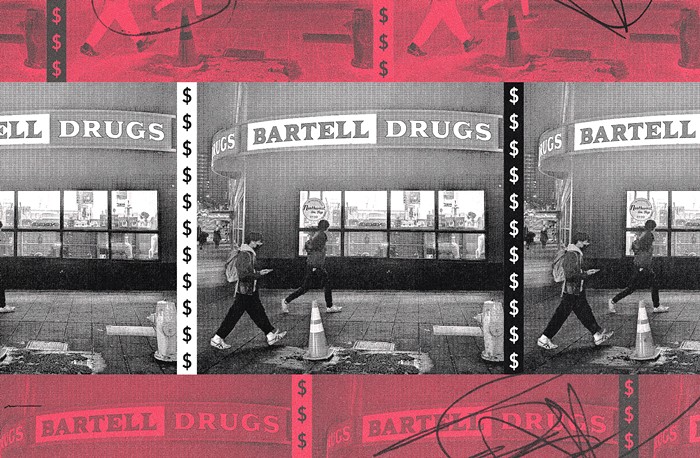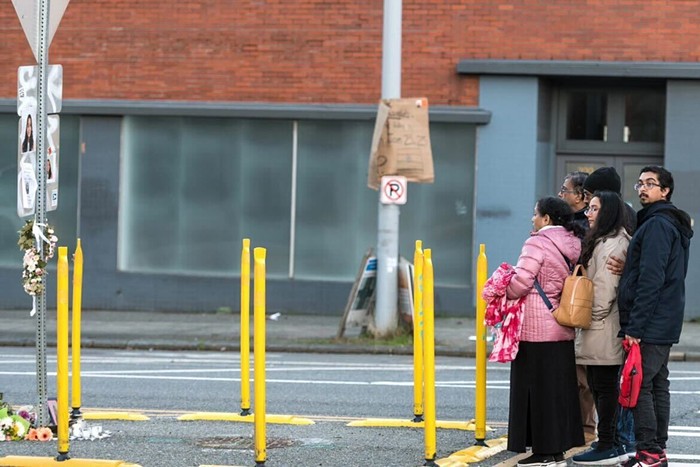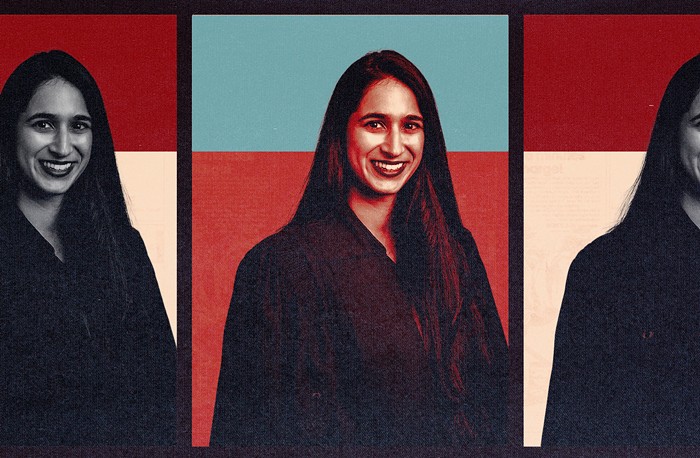The debate that follows a shooting like the one outside McCabe's is predictable: On one side, police and city officials link the violence with contemporary black music and culture; on the other side, club owners and activists complain that clubs that play hiphop music are harassed by the police because their clientele is predominantly African American.
The police-bias-is-the-problem position has been championed by businesspeople like Chris Clifford, who used to own the now-defunct Jerseys All American Sports Bar.
"[There is a] pattern and practice of targeting establishments which draw a black crowd, based on illegitimate racial profiling and racial stereotypes," Clifford's attorney Suzanne Thomas once told The Seattle Times.
The black-music-and-culture-is-the-problem position was most notably championed by former Seattle City Attorney Mark Sidran.
"Hiphop, the clientele and the violence is irrefutable," Sidran once told The Seattle Times.
There has been little to no progress on the "problem" of black entertainment in the Seattle area because both sides of the debate have stuck to their rigid positions. City officials blame the music; club owners and activists cry racism. The reason why both camps refuse to relent is that both are essentially correct. Club nights that attract African Americans are more volatile than other types of club nights. Police scrutiny of various kinds of clubs is inconsistent, with black clubs coming in for greater scrutiny--and some city officials, without a doubt, make baldly racist comments. Mark Sidran once called Clifford's Jerseys All American Sports Bar "a swamp," and described Clifford's African-American patrons as "alligators" (Seattle Times, October 31, 2000).
But just pointing to racist city officials and cops does not change the fact that "hiphop nights" in our city are plagued by dangerous and sometimes deadly public disruptions. Two men did really and truly die in front of McCabe's American Music Café on April 4. Most of the young black entrepreneurs who produce hiphop events around town are acutely aware of the problem and welcome a police presence at their shows. "I think that police presence is good," said Anthony Hollis, who until recently produced the "hiphop night" at Capitol Hill's Club Nine16. "It's an excellent idea to have some type of authority figure [near the club] because, once again, it sets the tone for whatever's going on.... The police are there to help us, so just having the police there at big events helps."
Hollis is a hard-working businessman. He wants to make money, and rap music happens to be a hot product. He can produce shows with a reasonable investment, and makes reasonable returns. Hollis is not glamorous; he doesn't dress up and act like a playa. Instead he is casual and polite, like someone who runs an electronics store or manages apartment buildings.
When I ask him if after-show disturbances are connected to black entertainment events like the kind he produces, Hollis says, "Black people, you know, are extravagant--we're very creative, and flamboyant in some ways, and that just shows when you get out there in the parking lot. There's people [in the parking lot] that you probably wanted to talk to inside, so you say your final words and keep moving on. But as far as the negativity or anything like that, that shit is spawned from somewhere else; it's something that happened way beforehand and just spilled over into the nightlife. It doesn't really have anything to do with the event."
The idea that the "negativity" is spawned elsewhere--a vendetta, for example, between old enemies who recognize each other inside a club--is something of a dodge. Hollis is claiming that "hiphop nights" are the terminal point for established conflicts. Naturally, Hollis does not want these disturbances connected with his business, and would like the police, city officials, and others in the business community to see the problem as something that comes to the clubs from other distant places and times.
On Thursday, February 28, at 1:30 a.m. a crowd poured out of a Kirkland club that bears the curious name Taps 'N' Tabs II. It was "hiphop night," and a number of nightclubbers lingered around the parking lot, talking and arguing. At 2:30 a.m., a thug pulled out an automatic weapon and fired 10
rounds in every direction. The "gun clapping" shattered the window of a nearby beauty salon and riddled a fleeing car with bullet holes. The alleged shooter was a convicted criminal named Felise Kaio Jr., who in 1998 killed a man in Unalaska, Alaska, with a barstool during a fight over a woman.
The Kirkland Police Department isn't happy with Taps 'N' Tabs, a club that started a "hiphop night" two years ago. Since the nights began, there have been 93 reported "disruptions" at Taps 'N' Tabs, and Kirkland police claim the club is taxing their limited resources. On Taps 'N' Tabs "hiphop" Tuesdays, the Kirkland Police Department has five on-duty police officers, and often three them are tending to some incident at Taps 'N' Tabs.
After the February 28 incident, the City of Kirkland requested that the Liquor Control Board revoke the club's liquor license until it "discontinued its Tuesday-night hiphop event." But it's actually an error to call Taps 'N' Tabs' programming on Tuesday (and occasionally Wednesday) a "hiphop" event. The music that's played at Taps 'N' Tabs--and at the nights Hollis produces, and at other clubs that have been the frequent sites of shootings and violence--is not hiphop, but rap. "There's a difference between hiphop and rap," explains DJ Funkdaddy (Greg Buren), the premier DJ in Seattle's "hiphop night" circuit. "Though white and black people like rap, it's mostly whites who are into hiphop."
When people learn of an upcoming show by a hiphop group like Public Enemy or De La Soul, Funkdaddy went on to explain, they assume that a lot of black people are going be there. "But if you go to any of those concerts at the Showbox or whatever, there's nothing but white people," Funkdaddy says.
Anyone who has attended a proper hiphop show, like the breakdancing-and-DJ extravaganzas at Nation, or a Boom Bap Project performance at the Showbox, or a concert headlined by the Roots, realizes that the art form, though initiated by African Americans and Puerto Ricans, is now supported by an overwhelmingly white audience. Indeed, there is a whole new generation of white hiphop artists (New York's EL-P and Aesop Rock, Minneapolis' Eyedea and Abilities, Seattle's Jeremy Moss) filling the creative gaps left by black flight into the more lucrative and rhythm-driven business of rap. And if we take the time to distinguish rap from hiphop, as Funkdaddy does, the situation in Seattle's clubs becomes clearer.
Hiphop, which inspires head nodding rather than rump shaking, has been losing its black audience since the mid-'90s. With the exception of Outkast, there hasn't been a bona fide Top 40 hiphop band since the Wu-Tang Clan, whose long fall from the top of the pop charts began around 1998. Indeed, if one looks at the current black charts (which Billboard calls R&B/Hip-Hop charts), they'll find it's dominated by rappers like Ludacris, Ja Rule, Nas, and Jay-Z. It is rap music, not hiphop, that sells millions of CDs every year, and it is rap, not hiphop, that fills the playlist at the most popular radio station in Seattle, KUBE 93.
When Stuck Under the Needle productions started a hiphop night on Sundays at the new Capitol Hill club Chop Suey, an e-mailed press release made it clear that they would not be playing "horrible mainstream, crossover shit with the blingy eight-bar rap and the R&B diva on the hook." In other words, they would not be playing rap. Instead, they would be playing "stuff like De La Soul, Talib Kweli, Eric B. & Rakim, Wu-Tang Clan, Tribe, Brand Nubian, Pete Rock & C. L. Smooth, Gang Starr, and Common"--hiphop.
I attended Stuck Under the Needle's hiphop night recently and was pleased to hear what KRS-One famously called "hardcore hiphop." There was very light security at the club: just one friendly bouncer. Though there were blacks and Asians, the crowd was primarily white: white b-boys, b-girls, regular hipsters, and intellectual types for whom hiphop culture has become a serious academic concern. DJs did not spin the latest releases and hits (indeed, they often went deep into the past and retrieved a forgotten but seminal hiphop record), and the dancers that dominated the floor were highly skilled breakdancers.
The following Sunday I attended Funk-daddy's Kotton Klub night at the Catwalk in Pioneer Square. Kotton Klub features the blingy eight-bar rap and the R&B diva on the hook that Chop Suey does not, and consequently attracts a predominantly black audience--and an army of bodyguards and bouncers, at least one of whom has had extensive military training. The atmosphere in Kotton Club was less heady and more focused on the groove, on the dancing. At one point in the night, two beautiful women took command of the dance floor and practically copulated before a crowd of pleased gentlemen and appalled ladies. One woman repeatedly slammed her groin into the ass of her partner, and never lost the beat of the rap song. I couldn't take my eyes off of these women. There were no intellectuals in sight, no expert breakdancers, no dazzling gymnastics--only what A Tribe Called Quest once called "hot sex."
On Sunday, January 27, a group of 300 or so nightclubbers poured out of Rock Bottom's "hiphop night," which is called Hollywood Nights and featured DJ Supa Sam from the popular radio station KUBE 93. The crowd did not disperse, and "a large-scale disturbance erupted," according to a Seattle Police Department incident report. "[I] saw suspect kick an unknown black male wearing light clothing," wrote officer R. Smith in his report. "This caused the victim to fall down. The suspect then pulled out a Glock handgun from his waistband and pointed it at the unknown black male." Rock Bottom no longer holds a "hiphop night." On April 14, Hollywood Nights moved to Vito's on First Hill, according to the invaluable and comprehensive calendar on Seaspot.com (which covers black entertainment events from the Puget Sound to Northern Idaho).
A wide spectrum of black personalities attend rap events: the bus driver, the accountant, the teacher, the pro basketball player. (Funkdaddy's events are beloved by several Sonics players, including Vin Baker.) Hiphop shows attract a variety of personalities as well: the bohemian, the waitress, the receptionist, the city council member. But only at rap shows do you see the thug--and the thug is always present. Hiphop nights don't attract thugs, which is why a place like Chop Suey has light security on its hiphop night.
So long as there are venues for rap, there will be thugs at rap shows--and bouncers and bodyguards. Why? Because thugs are the stars of rap music. Hiphop has a more diverse gallery of heroes; in fact, during its formative period (1981 to 1989) hiphop was defined by a multiplicity of characters, as demonstrated in hit songs like U.T.F.O.'s "Split Personality." The hiphop realm teemed with personalities: There were aristocratic aesthetes like Slick Rick, pro-black activists like Chuck D., intellectuals like Chill Rob G., geeks like the Jungle Brothers, goofballs like the Fresh Prince, and thugs like N.W.A. In rap, however, there is only the thug.
The thug stands in total opposition to everything white America defines as normal, and for that reason holds great appeal to masses of African Americans. Thug rapper Trick Daddy emphasizes this opposition to white standards in the titles of his popular CDs: www.thug.com, Book of Thugs: Chapter AK Versus 47, and my personal favorite, Thugs Are Us. Superstar rapper/thug Ja Rule, who performed at KUBE 93's sold-out 21st birthday party on April 10, also stands in opposition to white, middle-class codes of decency. His raps alternate between two shocking extremes: the hypersexual ("I don't respect shit, with diamonds and live reckless/Pushing the six, top speed, getting my dick licked/I'm childish"--from "Thug Life") and the hypercriminal ("Witness what it is to be real niggaz/Guns, drugs, hot slugs, coke runs.../Tearing your whole clique then we clip up/Nigga that's what these murderers, nigga, that's us/What the fuck, is you ready to die right now nigga?"--from "Murda 4 Life"). This scandalous rejection of white norms also fascinates and draws a large--and usually young--white audience. "Gangster rappers and such," writes critic Stanley Crouch in the anthology Black Genius: African American Solutions to African American Problems, "represent an opportunity for suburban white kids to go on what I call an audio safari.... All they have to do is go to Tower Records, and they can be transported straight to the black American jungle."
The thug is not only asocial but also apolitical. There is no "black rage" (in '60s sense of the term) in the rap thug; he doesn't think about society in any profound kind of way. All that matters to him is instant gratification from the usual ghetto sources: drugs, alcohol, and easy woman. The thug also never shoots white people. The thug's beef is always with other niggas--thugs only ever shoot other niggas. This particularly bothers Chuck D. of the hiphop group Public Enemy. "It's hard for me to support an 85 percent white teenage audience screamin', 'Smoke that nigger,'" D. wrote in the anthology Rhythm and Business: The Political Economy of Black Music.
If Ja Rule, who has smoked more than a few niggas on his CDs ("Ja is livin' stronger than a fucking coke rush/See on the streets we be killin' niggas like cash"), were to rap about shooting white people because white racism frustrates his opportunities in the real world, it would be hard to imagine his music being played on KUBE 93, let alone picture him headlining KUBE's 21st birthday party.
What is the appeal of the thug? The thug offers those of us who lead dull lives a chance to break out and feel the thrill of having no responsibility to law and order. This, as Stanley Crouch and many others have pointed out, is certainly the case with the white audience, and also middle-class blacks. Most African Americans who attend rap events like Funkdaddy's Kotton Klub actually don't live or even approve of the "thug life"--and most don't want to party with thugs either. Clubs go to great trouble to weed actual thugs out of their audiences. "You have to control the environment," Hollis explains to me. "And if there is a problem, if someone starts acting up, we have to deal with it right away."
"Rap music may be an expression of the sentiments of certain sectors of the African-American inner-city community," says King County Council Member Larry Gossett, the smartest African-American leader in the city. "But it certainly doesn't reflect all or even most.... Most patrons are able to put it in its context, have a good time, and go on home. Some might get overexcited, or even quote the artist, if they have a confrontation with somebody when they get out in the parking lot, and that's unfortunate and also has to be addressed. But there should be venues where this type of music can be played and enjoyed."
Though many young people emulate the thug's appearance--the still-popular drooping-pants look is an imitation of an incarcerated thug's drooping pants (booked suspects are required to surrender their belts)--very few are actually thugs, nor do they care to pay the price of being a thug (which is usually life imprisonment or violent death). But they will pay to dance to a real thug's threats and fantasies. Indeed, for those in the rap business (performers and producers), the status of the thug is an invaluable commodity. They will go to extreme lengths to prove they are real thugs. For example, despite his millions, a businessman like P. Diddy works hard to be associated with thug realities like murder charges. Without street credibility, who will dance to his threats and boasts?
Suspect/thug description in "hiphop night" disturbance incident #02-41491: 24-year-old black male, red shirt, jeans, with hair in braids, and a goatee.
To rid themselves of real-life thugs, most rap shows in Seattle have dress codes: The Royal Esquire prohibits "hats"; Reitz's nightclub prohibits "hats, tennis shoes, baggy jeans, jerseys"; Rock Bottom prohibits "hats, sports apparel, sport shoes." Indeed, when I attended the reopening of Hollywood Nights at Rock Bottom (just before its move to Vito's), the aggressive bouncers were turning away young men (black, white, and Asian) in droves because they wore "hats, sports apparel, [and] sport shoes." Most of them, however, did not appear to be thugs.
"We can keep things under control if we enforce a stricter dress code," explains Funkdaddy, when I ask him about the effectiveness of dress-code policing at rap events.
"I don't think that enforcing a dress code works," says Marisha Wilson, a 24-year-old African American who recently stopped attending rap events because the scene had begun to feel "fake and untrue" to her. "Troublemakers and the ones that cause fights--the ones who come in with this you-step-on-my-toes-I'll-punch-you-in-the-face kind of attitude--they can get dressed up and get through the door. But a lot of times it's the average Joe Blow who doesn't cause any trouble and just wants to have a good time who gets turned away."
Attempting to keep the thugs out with dress codes is a bit absurd, not because it must (with unintended comic results) define the thug's tastes in clothes, but because the music played in the rap clubs is thug music, yet the one person who is barred from enjoying the music that celebrates his world view is the thug himself. Inside the club, a record plays superstar thug Jay-Z ("I got blood money/straight-up thug money"), while outside an actual thug is turned away by security because he dresses and acts like Jay-Z. America--both black and white--wants to dance to the thug's music, but they don't want to deal with or dance with or step on the shoes of a real thug.
At 3:00 a.m. on September 23, 2000, two thugs opened fire across the street from the Bohemian Café in Pioneer Square, which had just concluded its "hiphop night." Before the shooting, several fights broke out near the club; one of these fights escalated from threats to fistfights to a full-blown gun battle. Over 15 rounds were exchanged, leaving a 20-year-old man with a gunshot wound to the head, a 25-year-old man with multiple gunshot wounds to the abdomen, a 24-year-old man with a groin wound, a 24-year-old man with a chest wound, and a 30-year-old man with a gunshot wound to the groin. There is no simple answer to the black entertainment question, but certainly we can go far beyond the current impasse of racist city government versus negligent club owners. The problem cannot be solved by "draining the swamp" and suspending the civil rights of African Americans (music and dancing are protected forms of expression), nor is it productive to ignore troubling facts. Despite the problems that seem to dog rap shows, one thing is certain: Rap events should be allowed to happen in any part of our city or state; to do otherwise would be undemocratic. Indeed, by definition, democracy requires living within complexity--a circumstance most people who actually live in democratic societies fail to appreciate. It's much easier to be despotic than democratic; it's much easier to close down this, to ban that, than to find ways to live with it.
Enforcing dress codes won't solve the problem of thugs--just as Mark Sidran's oppressive tactics couldn't solve the problem and Chris Clifford's lawyers couldn't solve the problem. You can't keep the thugs out of rap, because the thugs are rap. If rap music is, as Larry Gossett maintains, an outgrowth and artistic distillation of the economic and social violence that is inflicted on African Americans, then only a complete restructuring of American society will solve the problem of thugs and rap. Absent that development, the problem of thugs and rap will only be solved through the evolving tastes of the African American community. One day thugs will fall from grace and fall out of fashion, and African Americans will create new icons, new models of coolness. But for now, at the center of popular black American culture (and popular American culture in general) is the thug. As long as that's the case, rap nights will be menaced by thugs.
At 1:30 a.m. on Sunday, April 28, 20 police cars stood in front of the Showbox as hundreds of people poured out of the popular Funk Night (actually a rap and R&B night). Funk Night has had serious problems with after-show disturbances, one of which involved "fights breaking out all around" and "a person running down the street, displaying a knife" (Officer Hall, December 23, 2001). The primary officer who observed the massive disturbance on December 23 was also present on April 28, along with his small regiment. The following day, Sergeant Arata informed The Stranger that there were no incidents that night, no reports filed. The excessive presence of the heavily armed police seemed to have prevented a rap-night disturbance.



















